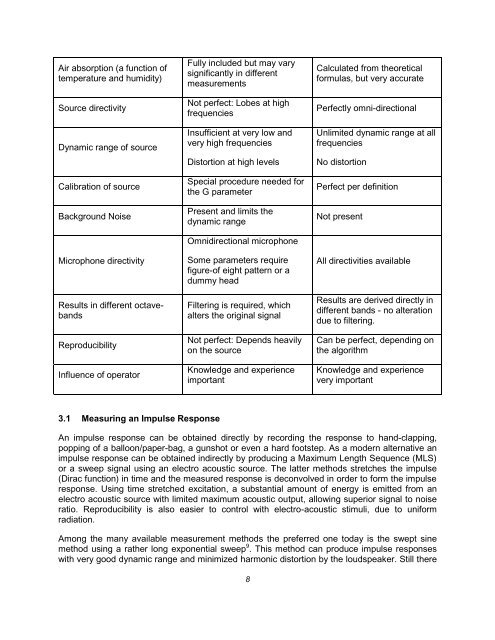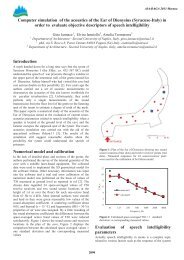paper - Odeon
paper - Odeon
paper - Odeon
You also want an ePaper? Increase the reach of your titles
YUMPU automatically turns print PDFs into web optimized ePapers that Google loves.
Air absorption (a function of<br />
temperature and humidity)<br />
Source directivity<br />
Dynamic range of source<br />
Calibration of source<br />
Background Noise<br />
Microphone directivity<br />
Results in different octavebands<br />
Reproducibility<br />
Influence of operator<br />
Fully included but may vary<br />
significantly in different<br />
measurements<br />
Not perfect: Lobes at high<br />
frequencies<br />
Insufficient at very low and<br />
very high frequencies<br />
Distortion at high levels<br />
Special procedure needed for<br />
the G parameter<br />
Present and limits the<br />
dynamic range<br />
Omnidirectional microphone<br />
Some parameters require<br />
figure-of eight pattern or a<br />
dummy head<br />
Filtering is required, which<br />
alters the original signal<br />
Not perfect: Depends heavily<br />
on the source<br />
Knowledge and experience<br />
important<br />
Calculated from theoretical<br />
formulas, but very accurate<br />
Perfectly omni-directional<br />
Unlimited dynamic range at all<br />
frequencies<br />
No distortion<br />
Perfect per definition<br />
Not present<br />
All directivities available<br />
Results are derived directly in<br />
different bands - no alteration<br />
due to filtering.<br />
Can be perfect, depending on<br />
the algorithm<br />
Knowledge and experience<br />
very important<br />
3.1 Measuring an Impulse Response<br />
An impulse response can be obtained directly by recording the response to hand-clapping,<br />
popping of a balloon/<strong>paper</strong>-bag, a gunshot or even a hard footstep. As a modern alternative an<br />
impulse response can be obtained indirectly by producing a Maximum Length Sequence (MLS)<br />
or a sweep signal using an electro acoustic source. The latter methods stretches the impulse<br />
(Dirac function) in time and the measured response is deconvolved in order to form the impulse<br />
response. Using time stretched excitation, a substantial amount of energy is emitted from an<br />
electro acoustic source with limited maximum acoustic output, allowing superior signal to noise<br />
ratio. Reproducibility is also easier to control with electro-acoustic stimuli, due to uniform<br />
radiation.<br />
Among the many available measurement methods the preferred one today is the swept sine<br />
method using a rather long exponential sweep 9 . This method can produce impulse responses<br />
with very good dynamic range and minimized harmonic distortion by the loudspeaker. Still there<br />
8
















